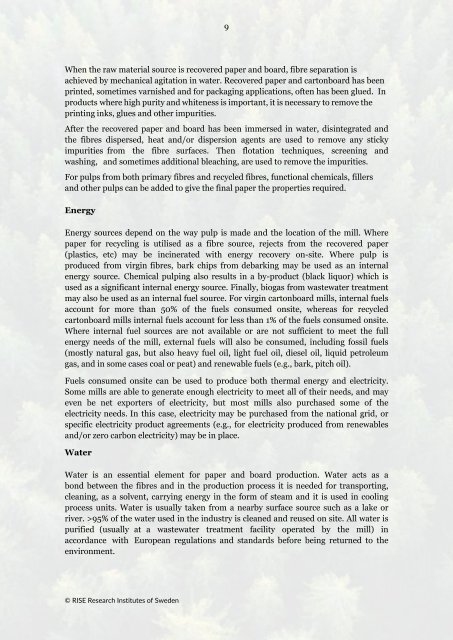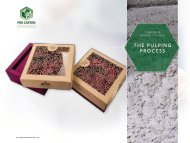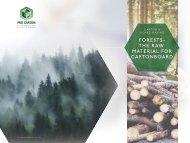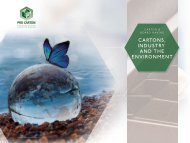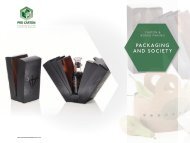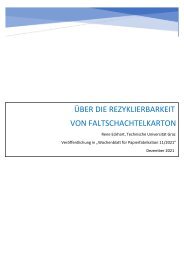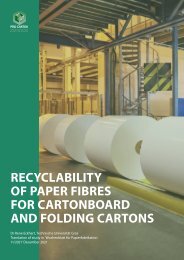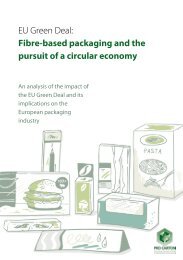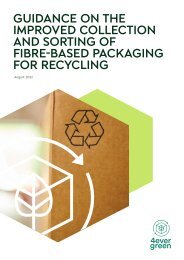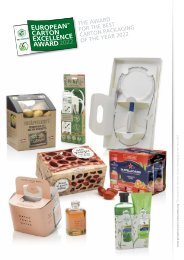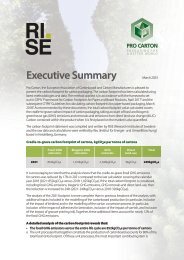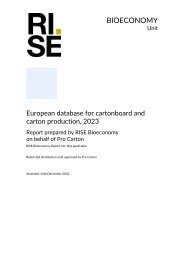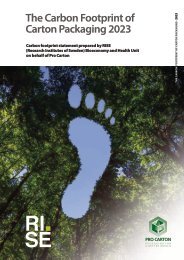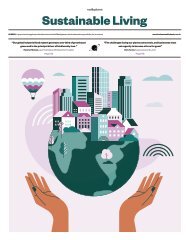European Database for Cartonboard and Carton Production 2023
Create successful ePaper yourself
Turn your PDF publications into a flip-book with our unique Google optimized e-Paper software.
9<br />
When the raw material source is recovered paper <strong>and</strong> board, fibre separation is<br />
achieved by mechanical agitation in water. Recovered paper <strong>and</strong> cartonboard has been<br />
printed, sometimes varnished <strong>and</strong> <strong>for</strong> packaging applications, often has been glued. In<br />
products where high purity <strong>and</strong> whiteness is important, it is necessary to remove the<br />
printing inks, glues <strong>and</strong> other impurities.<br />
After the recovered paper <strong>and</strong> board has been immersed in water, disintegrated <strong>and</strong><br />
the fibres dispersed, heat <strong>and</strong>/or dispersion agents are used to remove any sticky<br />
impurities from the fibre surfaces. Then flotation techniques, screening <strong>and</strong><br />
washing, <strong>and</strong> sometimes additional bleaching, are used to remove the impurities.<br />
For pulps from both primary fibres <strong>and</strong> recycled fibres, functional chemicals, fillers<br />
<strong>and</strong> other pulps can be added to give the final paper the properties required.<br />
Energy<br />
Energy sources depend on the way pulp is made <strong>and</strong> the location of the mill. Where<br />
paper <strong>for</strong> recycling is utilised as a fibre source, rejects from the recovered paper<br />
(plastics, etc) may be incinerated with energy recovery on-site. Where pulp is<br />
produced from virgin fibres, bark chips from debarking may be used as an internal<br />
energy source. Chemical pulping also results in a by-product (black liquor) which is<br />
used as a significant internal energy source. Finally, biogas from wastewater treatment<br />
may also be used as an internal fuel source. For virgin cartonboard mills, internal fuels<br />
account <strong>for</strong> more than 50% of the fuels consumed onsite, whereas <strong>for</strong> recycled<br />
cartonboard mills internal fuels account <strong>for</strong> less than 1% of the fuels consumed onsite.<br />
Where internal fuel sources are not available or are not sufficient to meet the full<br />
energy needs of the mill, external fuels will also be consumed, including fossil fuels<br />
(mostly natural gas, but also heavy fuel oil, light fuel oil, diesel oil, liquid petroleum<br />
gas, <strong>and</strong> in some cases coal or peat) <strong>and</strong> renewable fuels (e.g., bark, pitch oil).<br />
Fuels consumed onsite can be used to produce both thermal energy <strong>and</strong> electricity.<br />
Some mills are able to generate enough electricity to meet all of their needs, <strong>and</strong> may<br />
even be net exporters of electricity, but most mills also purchased some of the<br />
electricity needs. In this case, electricity may be purchased from the national grid, or<br />
specific electricity product agreements (e.g., <strong>for</strong> electricity produced from renewables<br />
<strong>and</strong>/or zero carbon electricity) may be in place.<br />
Water<br />
Water is an essential element <strong>for</strong> paper <strong>and</strong> board production. Water acts as a<br />
bond between the fibres <strong>and</strong> in the production process it is needed <strong>for</strong> transporting,<br />
cleaning, as a solvent, carrying energy in the <strong>for</strong>m of steam <strong>and</strong> it is used in cooling<br />
process units. Water is usually taken from a nearby surface source such as a lake or<br />
river. >95% of the water used in the industry is cleaned <strong>and</strong> reused on site. All water is<br />
purified (usually at a wastewater treatment facility operated by the mill) in<br />
accordance with <strong>European</strong> regulations <strong>and</strong> st<strong>and</strong>ards be<strong>for</strong>e being returned to the<br />
environment.<br />
© RISE Research Institutes of Sweden


